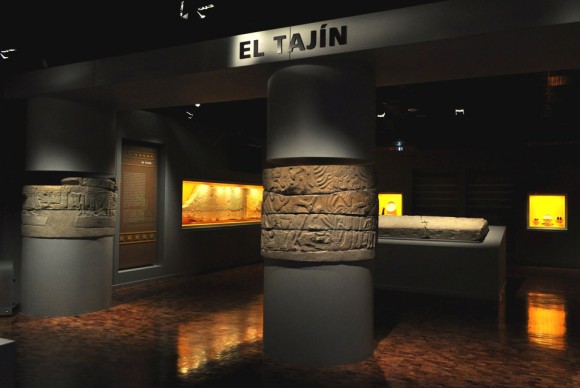El Tajin Columns to Be Exhibited for the First Time at National Museum of Anthropology
MEXICO CITY.- Shafts of the pilasters at the Building of the Columns, where one of the most enigmatic moments of El Tajin history is carved in bas-relief, will gather for the first time at the National Museum of Anthropology (MNA) in the great exhibition Seis ciudades antiguas de Mesoamérica. Sociedad y Medio Ambiente (Six Ancient Cities of Mesoamerica. Society and Environment), to be opened in March 2011.
Eighteen sandstone discs with a diameter of 108 centimeters, which juxtaposed reach a height of 100 centimeters, formed the middle part of 3 columns that must have supported the palace of an ancient ruler of El Tajin more than 1,000 years ago, in the area that today is the Mexican state of Veracruz.
The exhibition organized by the National Institute of Anthropology and History (INAH), is being mounted at the Temporary Exhibition Hall of the National Museum of Anthropology (MNA) where the pilasters of Edificio de las Columnas mark the entrance to the El Tajin section. The show that will gather more than 400 Prehispanic pieces will account for the ancient cities of Monte Alban, Palenque, Teotihuacan, Tenochtitlan and Tlatelolco.
The carvings at the shafts represent the narration of the arrival to El Tajin of ruler Thirteen Rabbit who conquered the city, changing deeply its architecture between 800 and 1200 of the Common Era.
“In the pilasters was depicted the moment when Thirteen Rabbit – of unknown origin- defeated the group in power and established himself”, declared archaeologist Patricia Castillo, curator of the section, indicating that the way the pilasters were displayed resembles the entrance to the Building of Columns, one of the last constructed in El Tajin, probably between 1100 and 1200 AD.
She mentioned that at the bas-relief of the architectural elements is observed Thirteen Rabbit himself, as well as one of his bravest warriors, Thirteen Skull, who holds a high-rank captive.
“At the center column, a scene stands out where lords wearing headdresses with 6 to 8 quetzal feathers”, expressed archaeologist Patricia Castillo, director of Veracruz INAH Center.
The specialist mentioned that another figure depicted that stands out is a priestess of the cult to Tlaloc, deity of water; the excellent work of stone allows observing the texture of the skirt she is wearing.
According to Patricia Castillo, “Socio-cultural evolution of El Tajin is marked by the arrival of Thirteen Rabbit, towards the Epi Classic period (800-1200 AD), who introduced an argument of religious unity when recurring to the images and symbols of 2 main deities: Tlaloc and Quetzalcoatl.
“Thirteen Rabbit established an ideology and a new social institution –represented by this duality-, constructing emblematic monuments that would mark time and space, a new symbolic system that determined and restructured historical processes, as well as becoming an announcer of the coming of Quetzalcoatl, the main deity”.
The INAH researcher pointed out that the exhibition 6 Ancient Cities of Mesoamerica. Society and Environment represents a unique opportunity to admire less-known pieces from El Tajin, among them, the discs of the Building of the Columns that are safeguarded at the archaeological zone.
She concluded that it will be in the section dedicated to El Tajin where the public will learn more about the relevance that the Ballgame court had for Mesoamerican peoples, by mounting pieces that represent yokes and palms elements associated to the ritual, considering that, until now, 17 courts have been registered at the Veracruz site.
Related posts:
- Research to Take Place at El Tajin Using LIDAR Technology
- Totonaca Mural Paintings Restored: Salts that Blocked Visibility were Removed
- Offerings to Tlaltecuhtli to be Exhibited at Moctezuma II
- Silver Forged Mexican History Exhibited
- Philly Exhibit at Museum of Archaeology and Anthropology Reopens with Chinese Mummies

